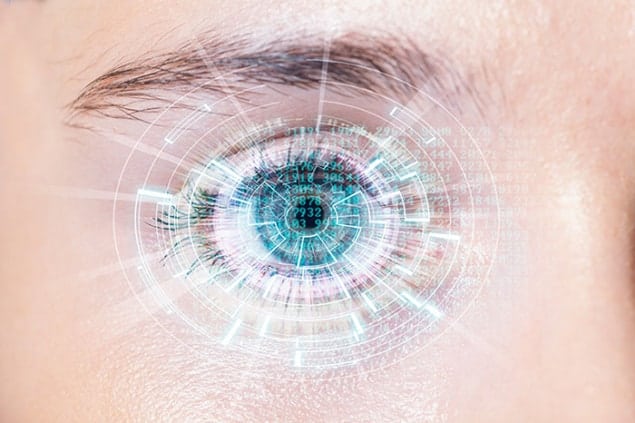
Scientists in Greece have devised a new form of biometric identification that relies on humans’ ability to see flashes of light containing just a handful of photons. The technique involves using very weak laser pulses to measure how a person’s sensitivity to light varies across their retina. According to its inventors, such a quantum-based retinal map could provide a more powerful and secure form of identification than is possible with conventional biometrics such as fingerprints or iris scans.
It has been known since the 1940s that humans are able to detect light pulses containing very few photons. However, whether we can actually see single photons is still unclear: one group last year said it had carried out experiments showing this to be the case but others questioned the claim. In the 1940s, Selig Hecht and colleagues at Columbia University in the US showed that variations in our perception of very low light levels are in fact governed by quantum statistics. By exposing several individuals to very dim flashes of light of differing average intensity, they found that the intensity-induced variation in the probability of seeing a flash could be modelled by assuming that the actual number of photons a person sees follows a Poisson distribution.
This result held true across the different people examined, although the specific responses depended on an individual’s value of alpha – a parameter describing the fraction of photons arriving at a person’s eye that are then detected by their retina. Losses caused by absorption or scattering within the cornea, pupil, lens and body of the eyeball, as well as a finite probability of absorption within the retina itself, means that alpha typically varies between 0 and 0.2. This variation led to a series of curves describing seeing probability versus average intensity, whose precise shape depended on alpha.
Unique variations
In the latest work, Iannis Kominis of the University of Crete and colleagues use these variations as the basis of the new biometric scheme. They say that the value of alpha changes by up to a factor of 100 from one point to another on an individual’s retina, while variations between retinas can be up to 50%. As such, they argue that people could be uniquely identified by precisely mapping the variation of alpha across their retinas.
The “alpha map” of a particular individual, who the researchers call Alice, would be created by exposing that person to large numbers of very weak laser pulses. The pulses would have a range of average intensities, and the exercise would be repeated across multiple points on Alice’s retina. For each pulse, Alice would be asked whether or not she saw a flash of light. With the map stored on a secure database, Alice could then be identified by examining a subset of points on her retina. Again, she would be exposed to a series of weak laser pulses and asked on each occasion whether or not she sees the pulse. Only if her answers closely match what would be expected from her map would she be allowed to proceed.
As Kominis and colleagues explain in a preprint uploaded to the arXiv server, Alice must be subject to a sufficient number of yes/no interrogations to limit two types of error as far as possible. One type of error is the “false negative”, which means that Alice is not recognized as herself. The other type is the “false positive”, in which an impostor, known as Eve, successfully fools the system into thinking that she is Alice.
Fifty interrogations
For the scheme to be implemented on a practical timescale, the number of interrogations must be limited. Simply choosing a random subset of points on Alice’s retina would involve 2500 interrogations to reach certain benchmarks – generating a false negative less than once every 10,000 identifications and a false positive less than one every 10 billion. However, by refining their technique in a number of ways – choosing only very low or very high alpha regions on the retina, using Bayesian statistics and employing pattern recognition – the researchers calculated that just 50 interrogations would do the job.
In addition, they assessed how well their scheme would cope if Eve was able to measure the number of photons entering Alice’s eye as well as monitoring her brain activity. Their conclusion: Eve would need to make extremely precise measurements of both the thermal energy dumped in Alice’s eye and the magnetic energy emitted by her head – something that would be very difficult to achieve.
Rebecca Holmes of the University of Illinois in the US praises Kominis and colleagues for having “put a lot of thought into how to optimise” their biometric technique. But she says she is “sceptical” about the scheme’s practicality, pointing out that up to half an hour would be needed just to acclimatize Alice’s eyes to the very dark conditions required. Holmes also disputes the technique’s “quantum” label, arguing that although it involves small numbers of photons, it does not provide a physics-based guarantee of complete security, as quantum cryptography (in principle) can do.



